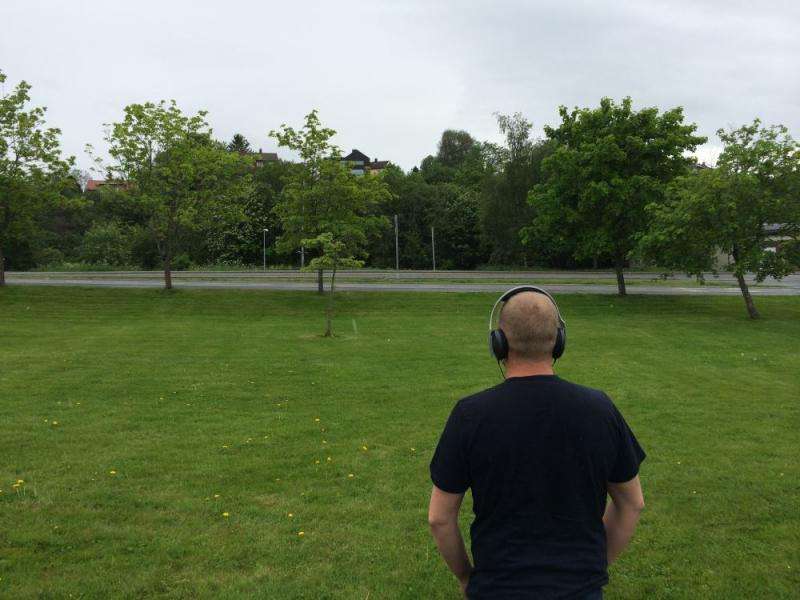Listening to roads before construction

They're going to build a new road right outside your living room window. The authorities have sent you a 'noise map', but what you really need is to hear what the traffic noise will sound like. Well, soon you can.
Being handed a number with a colour-coded noise map is no substitute for actually hearing the sound you're going to be exposed to. Some young researchers at SINTEF have understood this problem, and are developing a simulation tool that can generate the noise similar to what might be expected from a planned construction project, even before any changes have been made!
Noise kills
Cardiovascular diseases caused by traffic noise are responsible for the deaths of almost 150 Norwegians every year.
When an airport is planning to increase traffic, or new roads have to be built in residential areas, or when a stretch of the E6 highway has to be redeveloped and moved a few metres, the authorities are quick to make colourful noise maps to show us what the impact will be.
"But this is too abstract for most people", says Erlend Viggen at SINTEF ICT. "And it's difficult to envisage what the noise will really be like. It's much better to generate an artificial noise that people can listen to before construction goes ahead", he says.
Visualising sound
The researchers call this auralisation, or visualising sound. So far they've spent a year, and the institute's own funds, in developing the tool they call MAUS. This is pure simulation software designed to recreate what it's like to be a listener in close proximity to a sound source.
Similar techniques are being used around the world to model the acoustics in concert halls, churches and railway stations before such buildings are constructed. The advantage of this approach is that a construction plan can be improved in advance instead of having to carry out modifications after the building is completed.
Viggen shows us a model of a parking lot on a big screen. "This site is located just over the road here close to NTNU", he says. "We've modelled the construction of a road just here", he says, pointing to the screen. "And here's our 'listener', standing right in the middle".
The researchers have made recordings of a car using microphones located on the front and rear bumpers. The car travels at constant speeds of 30, 50 or 80 km/h, and these are the basic sounds that are input to the software.
"If you were standing here as the car passes by, the sound the car makes would change from the time you first hear it to the time it disappears", says Viggen. "We've indicated the different directions that the sound takes from the road to the listener using red lines, which we call sound paths. These are drawn into the model together with other lines indicating situations where sound is reflected and refracted due to the presence of adjacent buildings", he explains.
Then Viggen plays the sound out loud so that we can hear it. It sounds very realistic. He then moves the listener closer to the road and runs the programme again. This time the sound is louder.
What do road repair works sound like?
"If someone wants to repair a road and, let's say, construct a sound screen, local residents can of course look at a map and see how the colour codes change", says Viggen. "But it's still difficult to understand what the changes will really mean", he says.
He quickly inserts a small wall into the simulation model and generates a new audio image.
We can hear the car approaching quietly, and then the sound drops just as the car is behind the wall. As it passes beyond the wall, the volume increases rapidly again. In order to re-create the sound of traffic noise, and not just the sounds of a single car, many soundtracks have to be combined.
Applications
At the moment, only researchers are listening to these traffic sounds, but the scientists believe that there are some useful applications for this tool. For example, they believe that road developers will benefit from using MAUS.
All over Norway there are stretches of road generating too much noise, and that have to be modified. This can be achieved by erecting noise screens or constructing earth banks of suitable heights, or by other means such as reducing speeds or closing roads to heavy vehicles.
"We don't really know how this technology will be used in practice", says Viggen. "One idea is that the authorities may be able to conduct thorough tests to compare alternative noise-reducing measures before a final decision is taken. It's also possible that they might be interested in letting residents listen to different audio simulations so that they can have their say about which scenario seems to be the least troublesome. In this way it may be possible to avoid conflicts and expensive, subsequent modification work", says Viggen, who also insists that the tool will never be made openly available to the general public.
Provided by SINTEF





















